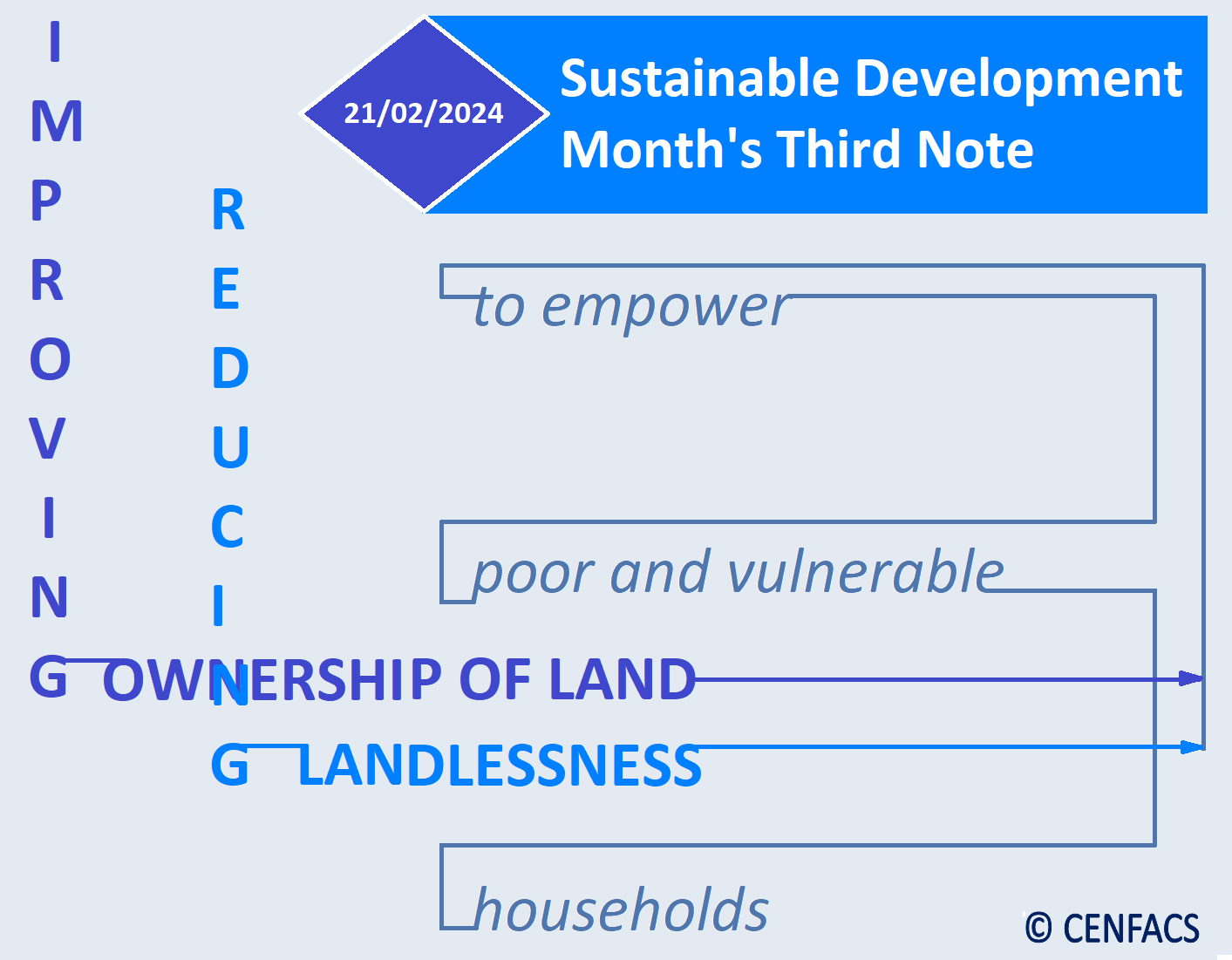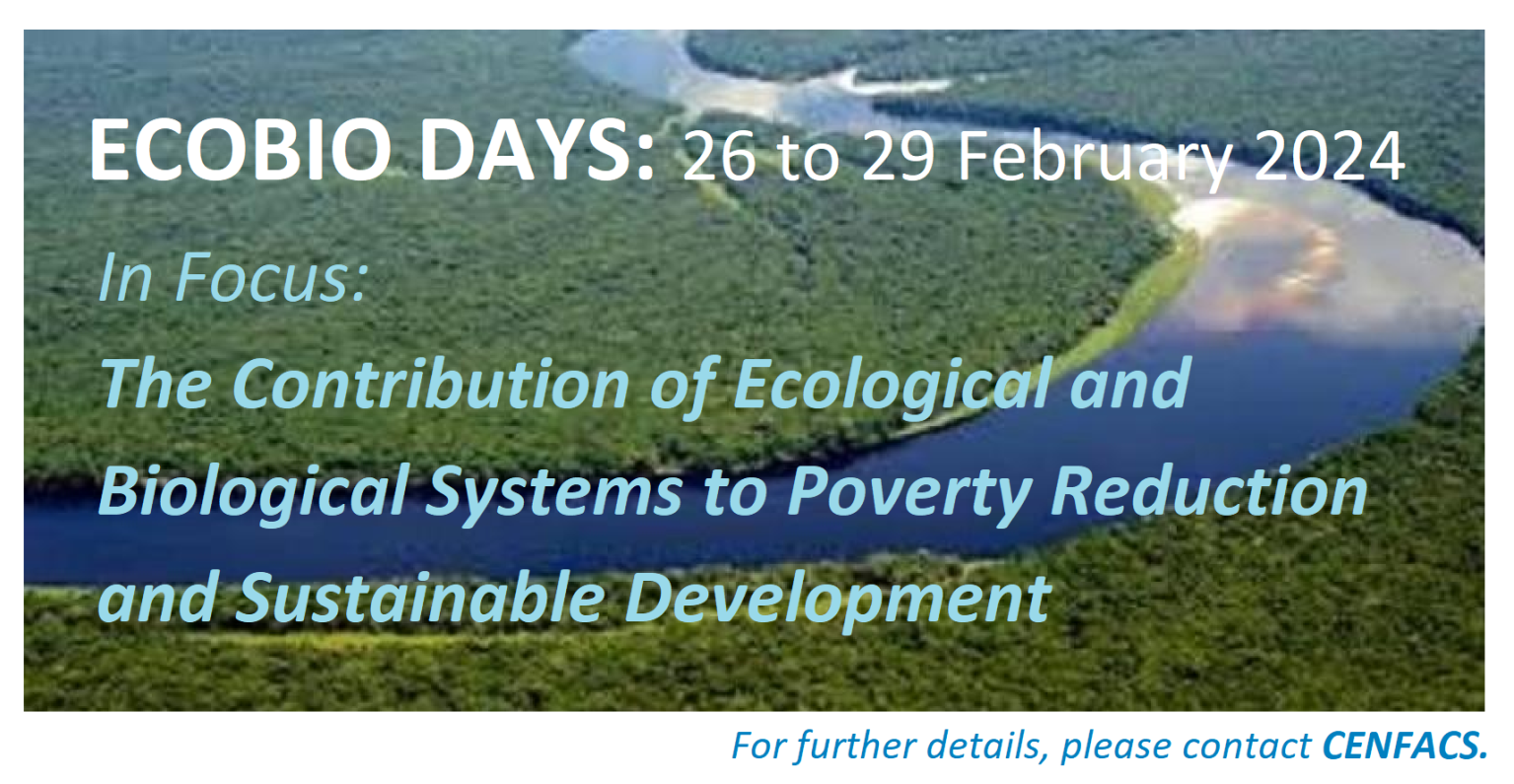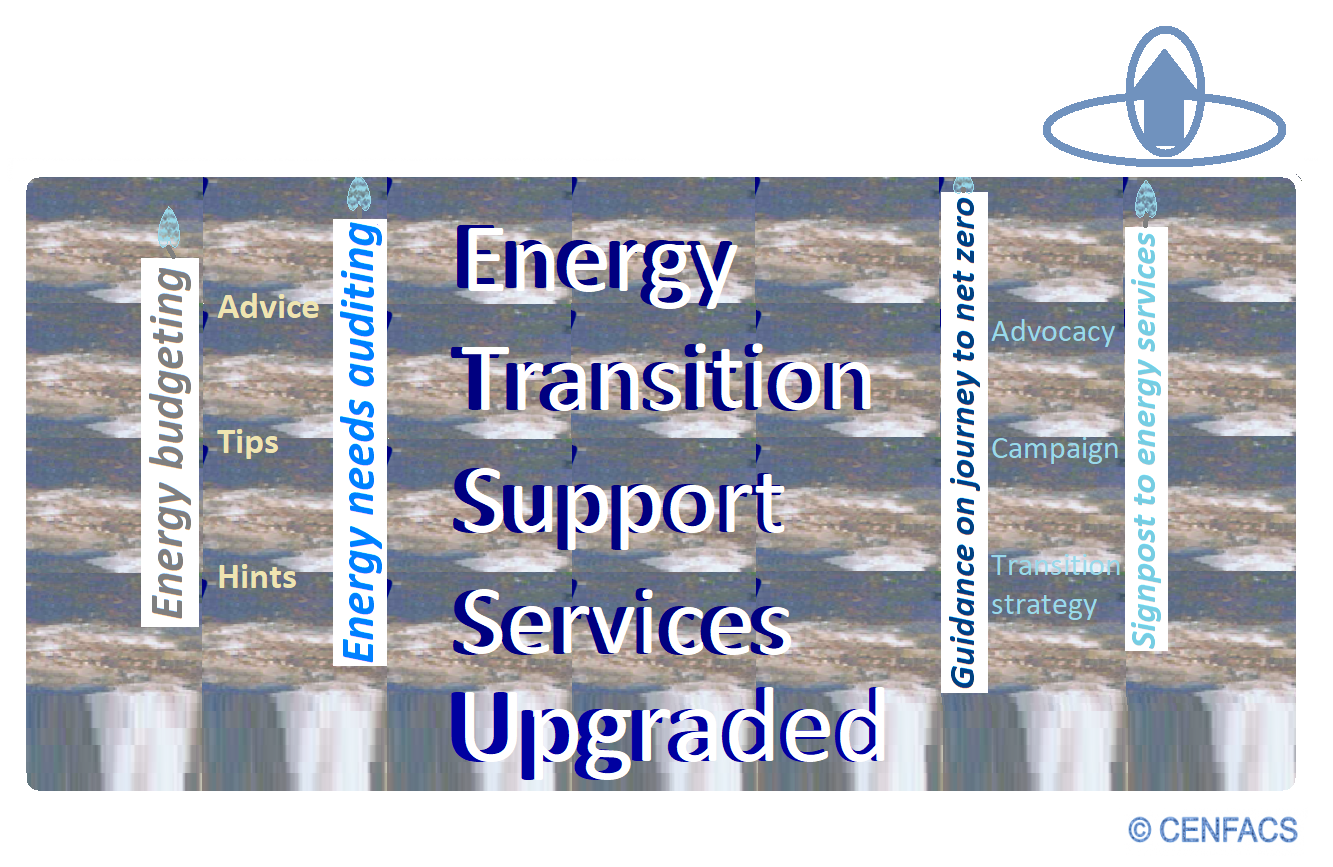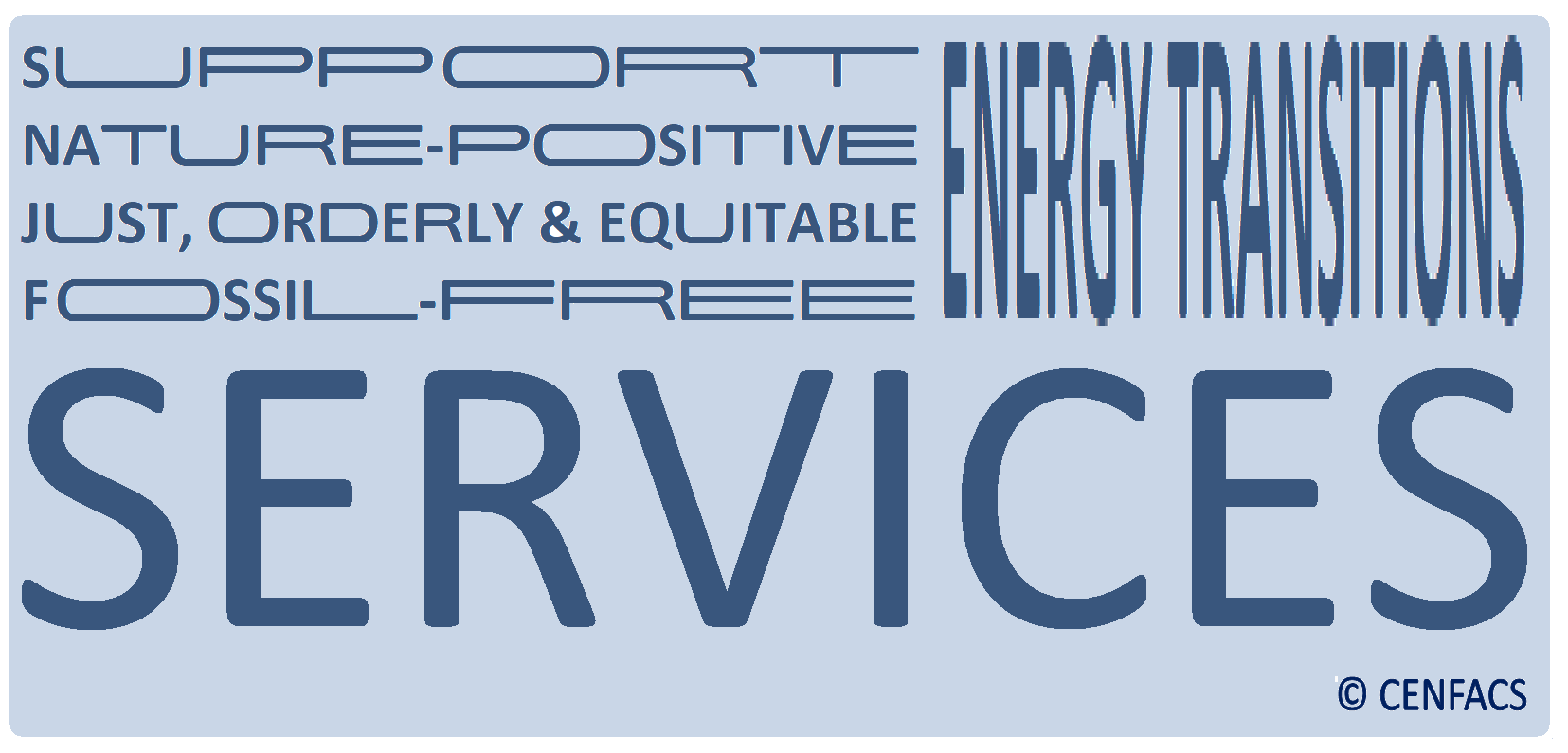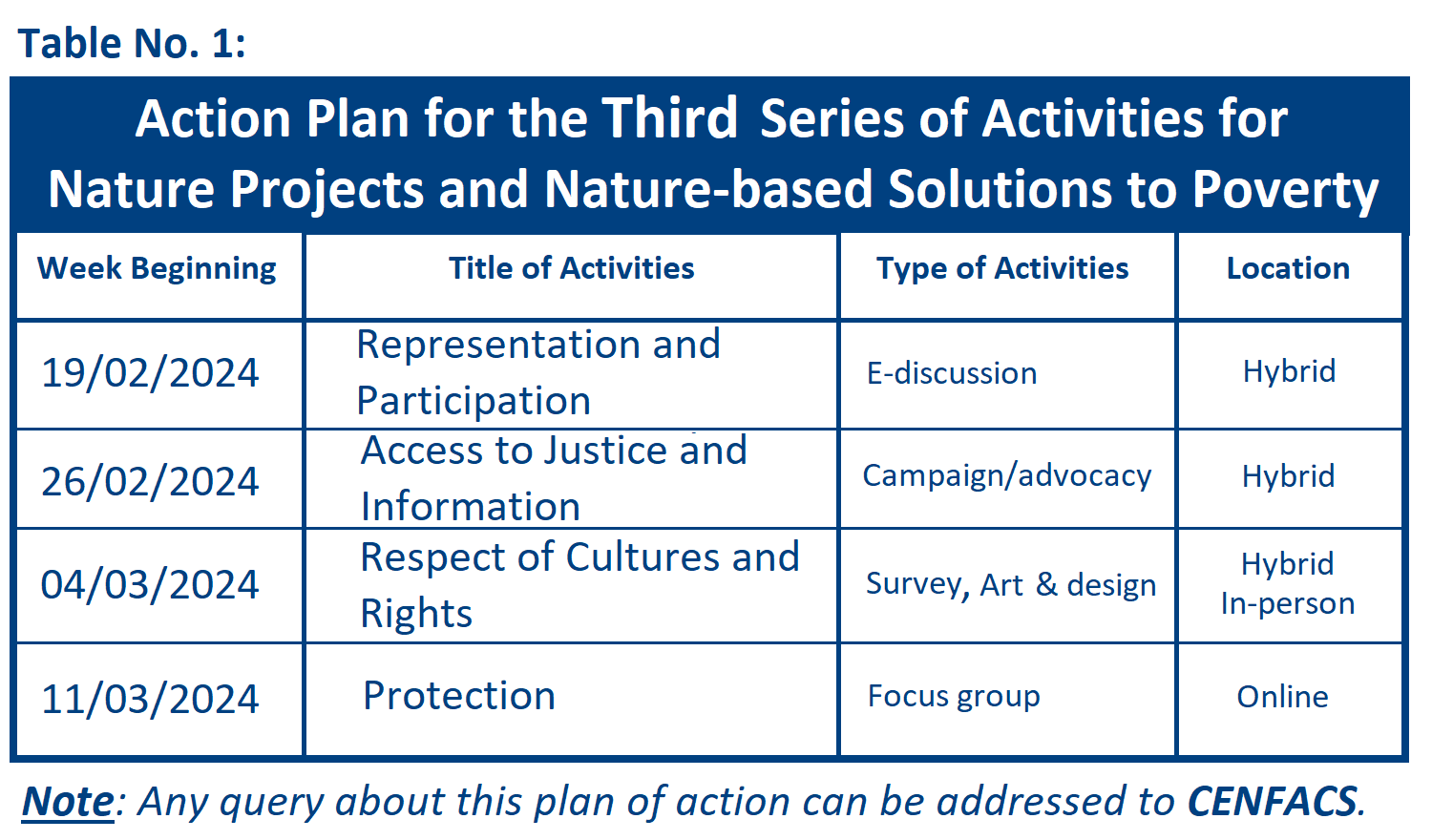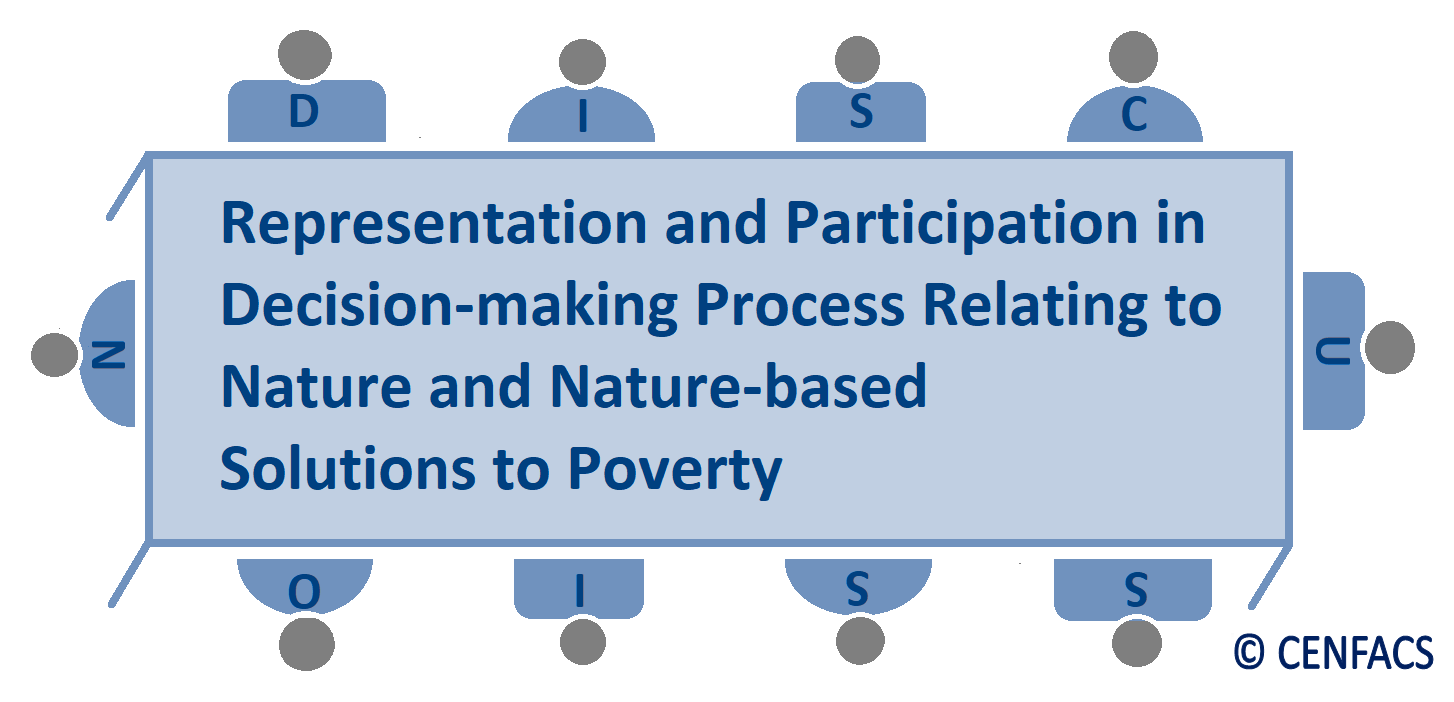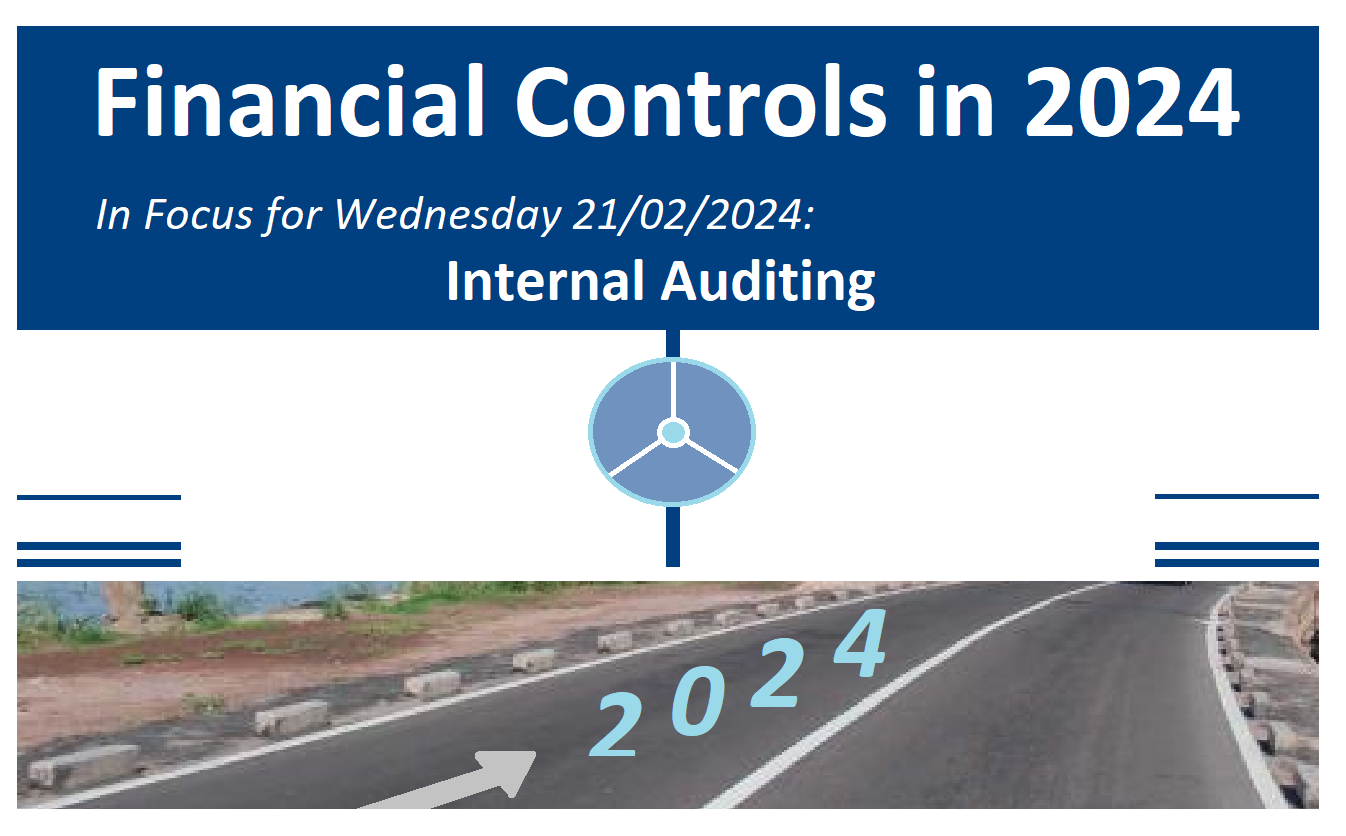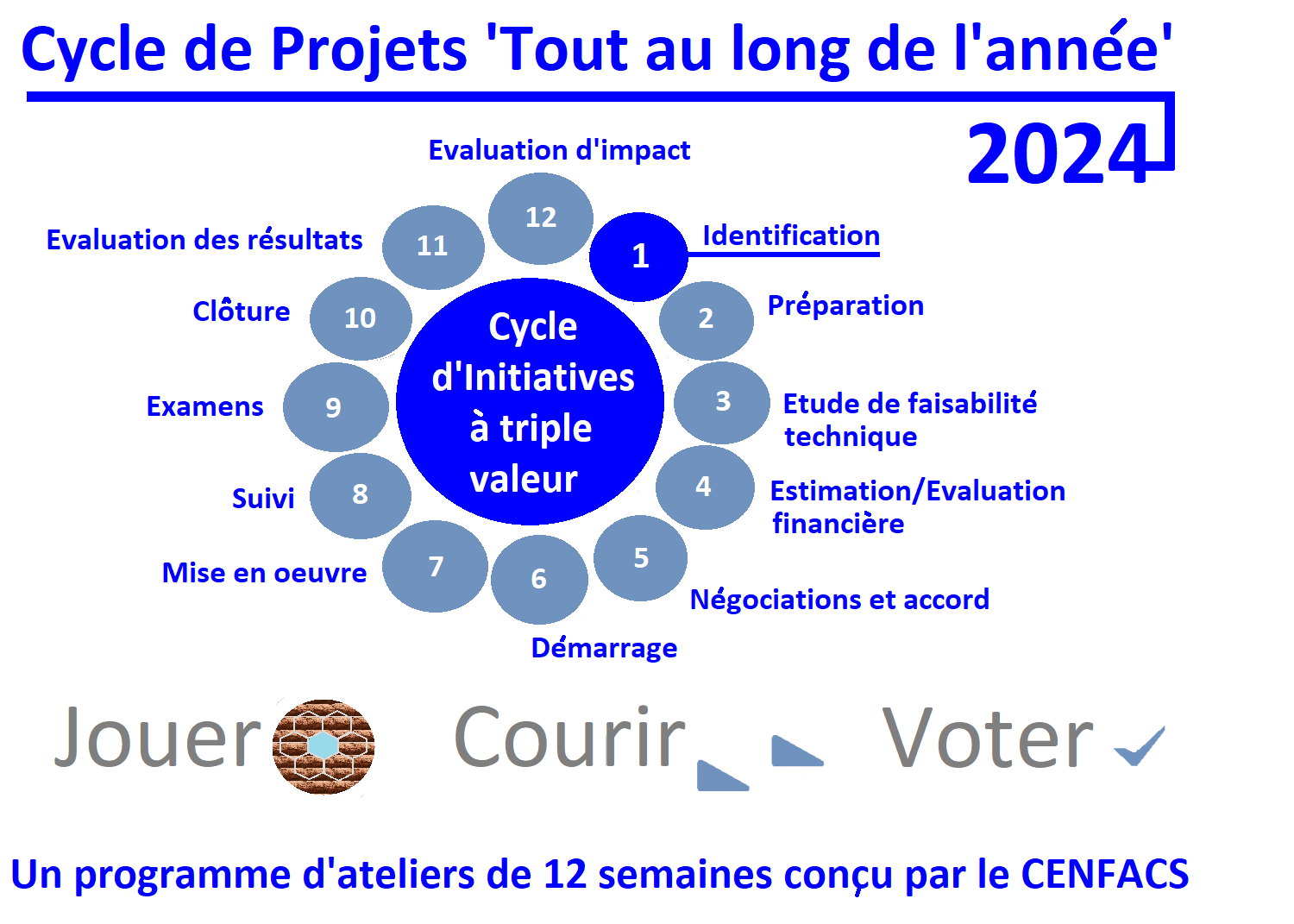Welcome to CENFACS’ Online Diary!
21 February 2024
Post No. 340
The Week’s Contents
• Improving Ownership of Land (Reduction of Landlessness) to Empower the Poor and Vulnerable Households
• Ecological and Biological (EcoBio) Days to Be Held from 26 to 29 February 2024
• Upgrades of Energy Transitions Support Services
… And much more!
Key Messages
• Improving Ownership of Land (Reduction of Landlessness) to Empower the Poor and Vulnerable Households (Note 3 of Sustainable Development Month on 21/02/2024)
Our work on the United Nations Sustainable Development Goal 1 of Ending poverty in all its forms everywhere continues, particularly with Target 4 of this Goal. In this target, we are currently dealing with ownership of land and other forms of property.
We are indeed working on ways of improving ownership of land or of reducing landlessness to empower the poor and vulnerable households. We are looking at any efforts deployed to reduce or end the lack of power over land and secure tenure to land by the poor and vulnerable households, particularly those households working with our Africa-based Sister Charitable Organisations.
As ‘landesa.org’ (1) argues,
“Land is a source of power, wealth, and livelihood”.
The same ‘landesa.org explains that
“When people do not possess rights to land, they are less likely to take action to protect the land and the natural resources it helps to cultivate. They also lack a basic asset that can empower them with opportunities for a home, loans, savings, and investment in their future”.
So, improving ownership of land or reducing landlessness can help empower the poor and vulnerable households. This improvement or reduction can result in the reduction of poverty and the enhancement of sustainable development.
The above is the first key message from this post.
More details about Improving Ownership of Land (Reduction of Landlessness) to Empower the Poor and Vulnerable Households can be found under the Main Development section of this post.
• Ecological and Biological (EcoBio) Days to Be Held from 26 to 29 February 2024
EcoBio Days are the period of time consecrated to the interrelationships between organisms and their environment as well as to the living organisms or natural processes of living things. This year’s EcoBio Days will focus on the Contribution of Ecological and Biological Systems to Poverty Reduction and Sustainable Development.
In order to extirpate the contribution of these systems, one may need to explain what these systems are.
• • Brief Explanations of Ecological and Biological Systems
To elucidate ecological system (or ecosystem), let us refer to the Oxford Dictionary of Environment and Conservation written by Chris Park (2). In this dictionary, it is said that
“Ecosystem is the natural interacting biotic and abiotic system in a given area, which includes all of the organisms (plants, animals, fungi, and microorganisms) that live in particular habitat, along with their immediate physical environment” (p. 139)
As to biological system, we have selected its definition from the one provided by Carlos Alcocer-Luaron et al. (3) who argue that
“A biological system is a set of self-organised differentiated components (elements) that interact pair-wise amongst themselves through various networks and media, isolated from other sets by boundaries called teguments and whose relation to other systems can be described as a closed loop in a steady-state… In argument with this definition, a living organism can obviously be regarded as a biological system, including any individual organism (i.e., a parasite) and the organs that constitute it, as well as their organisation”.
Since these two systems coexist with human systems, it is possible to draw that the two systems are naturally contributing to the lives of humans. However, beyond the environmental and conservationist arguments, there could be other contributions.
• • Beyond the Environmental and Conservationist Explanations of Ecological and Biological Systems
Ecological and Biological Systems could also contribute to the kinds of development humans would like to achieve like sustainable development. They could further help reduce some of the problems humans face, problems such as poverty of all kinds since humans depend on these systems to live and maintain their own systems.
So, 2024 EcoBio Days are not only about what the two systems (eco- and bio-systems) can do for themselves or to fix climate and nature crises. The days are also about what the two systems do or are doing to reduce or end poverty and enhance sustainable development. In other words, the days are about valuing ecosystem and biosystem functions and services for poverty reduction and sustainable development.
For further details or to engage with these EcoBio Days, please contact CENFACS.
• Upgrades of Energy Transitions Support Services
In December 2023, we announced that CENFACS would move into 2024 with nature-positive projects and programmes, as well as nature-based solutions to poverty. We also said that we would add to them projects of just, orderly and equitable energy transitions as well as fossil-free projects. Hope would be provided by other initiatives with Nature-positive Goals and Nature-based Solutions to Poverty. In addition to what we argued in December 2023, let us remind our audiences that Energy Transitions Initiatives within CENFACS started long time ago as the following status indicates.
• • Status of Energy Transitions Initiatives within CENFACS
In March 2022, we amalgamated the different types of energy support we provided to our members and the community. We put them under one roof which then we called Energy Transitions Support Services. The latter are the two Light Season’s Energy Projects, which included: a) Programme for Gradually Phasing Down Coal and b) Advocacy and E-workshops about Energy Transitions.
Since we are in the Year of Transitions (Year 2024) within CENFACS and the Month of Sustainable Development, we are recalling all our energy initiatives to forming an Energy Transitions Support Services (ETSS) Upgraded or 2024 Version.
• • What Does ETSS Upgraded or 2024 Version Consist of?
ETSS Upgraded or 2024 Version is made of the following:
√ ETSS 2022 Version
√ Nature-positive Energy Transitions
√ Projects of Just, Orderly and Equitable Energy Transitions
√ Fossil-free Energy Transitions.
ETSS Upgraded or 2024 Version is a programme of progressive work on energy matters that supports the CENFACS Community so that this community can continue its journey of energy transitions smoothly and surely. ETSS Upgraded or 2024 Version, which retains most of the components of ETSS 2022 Version, aims at the community’s energy consumption, production and behaviour towards a net-zero or fossil-free world. The support is part of CENFACS‘ dedication of the year 2024 as a Year of Transitions; energy transitions being one of them.
• • How to Access ETSS Upgraded or 2024 Version
Access to ETSS Upgraded or 2024 Version can be achieved by
√ Booking an appointment for support on energy transitions
√ Contacting CENFACS via phone, e-mail, text and completing the contact form on the page ‘contact-us’ of this website.
Services are free, confidential, open to everyone and held on a one-to-one basis or as a group and run by qualified, expert and committed volunteers. Although services are free, we do not mind voluntary donations of any amount from any service users.
Health protection and safety are included in the delivery of these services.
For any queries and/or enquiries about ETSS Upgraded or 2024 Version, please do not hesitate to contact CENFACS.
Extra Messages
• Nature Projects and Nature-based Solutions to Poverty: Working Plan for the Third Series of Nature Activities
• Financial Controls 2024 – In Focus for Wednesday 21/02/2024: Internal Auditing
• All-year Round Projects Cycle (Triple Value Initiatives Cycle) – Step/Workshop 1: Project Identification
• Nature Projects and Nature-based Solutions to Poverty: Working Plan for the Third Series of Nature Activities
This week, we are announcing the third series of activities that will continue to feature the new generation of Nature Projects and Nature-based Solutions to Poverty.
The third series of Nature Projects and Nature-based Solutions to Poverty will focus on four areas as follows:
a) representation and participation
b) access to justice and information
c) respect of cultures and rights
d) protection.
The contents of this third series of activities, which will be covered in 4 weeks, stem from nature goals of the Kunming-Montreal Global Biodiversity Framework (4), specifically some aspects of Target 22 of this Framework. They include those incorporated in Table 1.
• • Third Series of Activities
The four activities of this series are given below.
Activity 1: Representation and Participation
This activity will cover full, equitable, inclusive and gender-responsive representation and participation in decision-making process relating to nature and nature-based solutions to poverty.
Activity 2: Access to Justice and Information
This activity will be about ensuring access to justice and information related to biodiversity by indigenous people and communities.
Activity 3: Respect of Cultures and Rights
This activity will focus on the respect of indigenous peoples’ and local communities’ cultures and their rights over lands, territories, resources and traditional technology.
Activity 4: Protection
This activity will deal with the full protection of environmental human rights defenders.
The table No. 1 specifies the type of activities each of them is. The first activity – which is Representation and Participation – has already kicked off. Let us further explain Activity 1.
• • Nature Projects and Nature-based Solutions to Poverty – In Discussion for Week Beginning 19/02/2024: Representation and Participation
a) Aim of Activity 1
The Activity 1 is a discussion that aims at developing a relationship in which a person is acting on behalf of another, while getting people (mostly the excluded) involved in decisions that affect their lives.
This activity will cover full, equitable, inclusive and gender-responsive representation and participation in decision-making process relating to nature and nature-based solutions to poverty.
For example, the activity will include active participation of women to tackle nature issues (like environmental degradations) in decision-making processes and positions.
b) What does Activity 1 Consist of?
The discussion related to this Activity 1 will be on:
~ Creating a gender action plan relating to nature and nature-based solutions to poverty
~ Mapping out techniques to include and invest in women in nature-based solutions to poverty
~ Making safe and support women working on nature issues
~ Closing gender gaps in education, information and skills for women in matters relating to nature.
For those who would like to engage with Activity 1 and/or any of the above-mentioned activities, they should not hesitate to contact CENFACS.
For those who would like to find out more about Nature Projects and Nature-based Solutions to Poverty, they can also contact CENFACS.
• Financial Controls 2024 – In Focus for Wednesday 21/02/2024: Internal Auditing
Financial Controls project or exercise carries on this week as we are dealing with internal auditing in the context of households and families. What do we mean by internal auditing?
• • Basic Meaning of Internal Auditing
The meaning of internal auditing used here comes from the Institute of Internal Auditors (5) which explains that
“Internal auditing is an independent objective assurance and consulting activity designed to add value and improve an organisation’s operations. It helps an organisation accomplish its objectives by bringing a systematic, disciplined approach to evaluate and improve the effectiveness of risk management, control and governance processes”.
Households that would like to add value and improve their operations would conduct internal auditing. This sort of exercise will help households in the way they govern their processes. Those households that need support to conduct their internal auditing, they can ask CENFACS to work with them.
• • Working with Households on Internal Auditing
Working with households on this matter could include the following:
√ Helping them to understand their households’ cultures, systems and processes
√ Assuring that internal controls are in place for them to effectively run their households
√ Mitigating risks
√ Maintaining effective and efficient governance
√ Meeting households’ goals and objectives
etc.
The above is the second financial control we wanted to share with our users or beneficiaries who may be households.
If anyone of our members need support regarding their financial controls and in particular Internal Auditing within their household, they should not hesitate to contact CENFACS.
• All-year Round Projects Cycle (Triple Value Initiatives Cycle) –
Step/Workshop 1: Project Identification
The planning process for Triple Value Initiatives (or All-year Round Projects), which is under way, includes the different steps of project cycle, which are: Identification, preparation, feasibility study, appraisal, negotiations and agreement, start, implementation, monitoring, reviews, termination, outcome evaluation and impact evaluation.
These steps of All-year Round Projects Cycle (Triple Value Initiatives Cycle) will be completed in 12 weeks under a 12-week workshop programme.
This week, we are starting with Project Identification as the first step or workshop for our project cycle. Let us see what the potential user of All-year Round Projects or Triple Value Initiatives can undertake in this first workshop.
• • Workshop 1: Identifying Your Run or Play or Vote Project
In this first step of the cycle, those who would like to undertake a Run or Play or Vote activity need to identify their Run or Play or Vote project. What do we mean by that?
They need to develop a preliminary proposal for the most appropriate course of actions, within specific time and budget frames, to say how they are going to achieve the goal of Running or Playing or Voting.
For example, let us take Running. You could say you want to run 4 miles every Friday of the week in the morning in the local park and you plan to spend some few pounds on water bottle to refresh yourself, etc. You could also specific whether you want to run alone or as a group of people.
This identification will involve the following:
√ Reviewing alternatives approaches or options for addressing any problems with your Running or Playing or Voting activity
√ Defining the objectives of your Run or Play or Vote project/initiative to justify the resources to be committed
√ Identification of any major issues before implementing the Run or Play or Vote project.
The above is a basic starting point for project identification. For those who are not familiar with project identification and would like some support, they should not hesitate to contact CENFACS.
They can contact CENFACS by phoning, texting, e-mailing and completing the contact form on this website. We can together discuss in detail your/their proposals about either your/their Run or Play or Vote projects.
Message in French (Message en français)
• Cycle de projets ‘tout au long de l’année’ (Cycle d’initiatives à triple valeur) –Étape/atelier 1: Identification du projet
Le processus de planification des initiatives à triple valeur ajoutée (ou projets à durée d’année), qui est en cours, comprend les différentes étapes du cycle du projet, à savoir: l’identification, la préparation, l’étude de faisabilité technique, l’évaluation financière, les négociations et l’accord, le démarrage, la mise en œuvre, le suivi, les examens, la clôture, l’évaluation des résultats et l’évaluation d’impact.
Ces étapes du cycle de projets ‘tout au long de l’année (cycle d’initiatives à triple valeur) seront réalisées en 12 semaines dans le cadre d’un programme d’ateliers de 12 semaines.
Cette semaine, nous commençons par l’identification du projet comme première étape ou premier atelier de notre cycle de projet. Voyons ce que l’utilisateur potentiel de projets tout au long de l’année ou d’initiatives à triple valeur peut entreprendre dans ce premier atelier.
• • Atelier 1: Identifier votre projet ‘Courir ou Jouer ou Voter’
Au cours de cette première étape du cycle, les personnes qui souhaitent entreprendre une activité ‘Courir ou Jouer ou Voter’ doivent identifier leur projet ‘Courir ou Jouer ou Voter’. Qu’entendons-nous par là?
Elles doivent élaborer une proposition préliminaire sur le plan d’action le plus approprié, dans des délais et des budgets précis, pour dire comment elles vont atteindre l’objectif de courir, de jouer ou de voter.
Prenons l’exemple de la course à pied. Vous pourriez dire que vous voulez courir 6 km tous les vendredis de la semaine le matin dans le parc local et que vous prévoyez de dépenser quelques litres en bouteille d’eau pour vous rafraîchir, etc. Vous pouvez également préciser si vous souhaitez courir seul ou en groupe.
Cette identification impliquera les éléments suivants:
√ l’examen d’autres approches ou options pour résoudre tout problème lié à votre activité de course, de jeu ou de vote.
√ la définition des objectifs de votre projet/initiative ‘Courir ou Jouer ou Voter’ afin de justifier les ressources à engager
√ l’identification de tout problème majeur avant la mise en œuvre du projet ‘Courir ou Jouer ou Voter’.
Ce qui précède est un point de départ de base pour l’identification du projet. Pour ceux ou celles qui ne sont pas familiers(ères) avec l’identification des projets et qui souhaiteraient un accompagnement, ils/elles ne doivent pas hésiter à contacter le CENFACS.
Ils/elles peuvent contacter le CENFACS par téléphone, SMS, messagerie électronique et en remplissant le formulaire de contact sur ce site web. Ensemble, nous pouvons discuter en détail de leurs propositions concernant leurs projets ‘Courir ou Jouer ou Voter’.
Main Development
• Improving Ownership of Land (Reduction of Landlessness) to Empower the Poor and Vulnerable Households (Note 3 of Sustainable Development Month on 21/02/2024)
To compose this Note 3, we have appealed to the following items:
σ Definition of Key Terms
σ Link between the Reduction of Landlessness and Poverty Reduction
σ Advocacy for Lands to Empower the Poor and Vulnerable Households
σ Ways of Improving Ownership of Land
σ Working with the Community Members on Improving Ownership of Land or the Reduction of Landlessness to Empower Them.
Let us briefly explain the above-mentioned items.
• • Definition of Key Terms
In the Note 3 of our Sustainable Development Month, we are using four key terms which are: ownership, landlessness, empowerment, and secure tenure.
Let us try to understand the meaning of these key terms of Note 3.
1) Ownership
There are many ways of defining ownership. In the context of this Note 3, we have selected the definition of ownership from ‘britannica.com’ (6), which explains it as
“The legal relation between a person (individual, group, corporation or government) and object. The object may be corporeal, such as furniture, or completely the creature of law, such as patent, copyright, or annuity; it may be movable, such as an animal, or immovable, such as land”.
From this definition, ownership of land is the legal relation between a person and immovable object which is land. Ownership of land also means that that land is subject to tenure not to absolute ownership, according to the common law.
So, the purpose of this Note 3 is to improve the relation between households (the poor and vulnerable ones) and lands.
2) Secure Tenure
Tenure can be secure or insecure. In the context of this Note 3, we are interested in secure tenure. What is secure tenure?
The website ‘habitatforhumanity.org’ (7) explains that
“Secure tenure refers to the ability to use and control the use of land without the fear of eviction or penalty. It is the peace of mind of knowing that your home won’t be taken away without warning”.
This ability is important for the poor and vulnerable households as it is an indication whether or not they have the power on the land they possess.
3) Empowerment
To approach empowerment, we have referred to the explanation of Douglas D. Perkins (8) who argues that
“Empowerment is an intentional ongoing process centred in the local community, involving mutual respect, critical reflection, caring, and group participation, through which people lacking an equal share of valued resources gain greater access to and control over those resources; or a process by which people gain control over their lives, democratic participation in the life of their community, and a critical understanding of their environment (Perkins & Zimmeran, 1995)” (p. 207)
Perkins also contends that he prefers the definition of empowerment as a way of using strategies to gain and apply the actual power needed to make important, material improvements in community conditions and people’s lives.
It is this power we are dealing with in this Note 3 in order to improve the conditions of poor and vulnerable households.
4) Landlessness
The definition of landlessness is taken from the ‘dictionary.cambridge.org’ (9) which states that
“Landless is an adjective that refers to people who do not own any land for farming or who are prevented from owning the land they farm by the economic system or by rich people who own a lot of land”.
This term and definition will be used during this month to approach poverty linked to landlessness and how to reduce this type of poverty if one wants the Goal 1 of No Poverty to come true reality for the landless people. Additionally, we will be working on both land ownership and control in relation to poverty reduction.
• • Link between the Reduction of Landlessness and Poverty Reduction
There could be association between the reduction of landlessness and poverty reduction.
For example, Barbier and Hochard (10) studied the interaction between land degradation and poverty. They found that
“Over 2000-2010, the rural poor on degrading agricultural land increased in low-income countries and in Sub-Saharan Africa and South Asia. This degradation threatens the livelihoods of the poor”.
One thing is to argue about the above-mentioned links. Another is about advocating to reduce or end the types of poverty expressed through these links.
• • Advocacy for Lands to Empower the Poor and Vulnerable
The Month of Sustainable Development within CENFACS is also of advocacy for and on behalf of the poor (amongst them are poor and vulnerable households) and those in need of sustainable development so that the Reduction of Landlessness can materialise to Empower Them.
Our Advocacy for the Month of Sustainable Development covers Lands and/or Properties to Empower the Poor and Vulnerable Households. It is about speaking with and on behalf of landless families and households so that they can have safe and decent lands/homes to live; in doing so working with them to access affordable housing, defending their equal land and property rights, which should be for everyone.
For example, Martina Schwikowski (11), who explains why fewer Africans are able to own land, notes that
“[In Kenya], the richest 10% of the rural population control over 60% of land assets, while the poorest 50%own just over 3%, according to the researchers”.
Because of this situation in Africa, advocacy is strongly needed to empower poor and vulnerable landless households to become land owners in Africa.
More details about this advocacy work can be requested from CENFACS.
• • Ways of Improving Ownership of Land
There are ways of improving ownership of land (for instance, in Africa), which include the following:
√ good land governance
√ land registry that provides ownership of land
√ scaling up land reforms
√ formal documentation of land ownership
√ securing tenure rights for community and individual plots
√ rebalance between freehold system and customary systems
√ curbing corruption in land and property ownership
√ reducing the widening gap in land ownership and access
√ establishing a clear ownership of properties
√ reducing land inequality
√ setting up transparency on land
√ oversight on land sales and use
√ developing digital land administrative services
√ having data collection, aggregation and transparency about land ownership in Africa
etc.
For example, the ‘worldbank.org’ (12) suggests the following for Africa:
~ Increasing efficiency and transparency in land administration services by empowering local communities and traditional authorities
~ Developing capacity in land administration by encouraging policy reforms and providing training.
All these initiatives can only be possible to achieve by working with those who are the most in need.
• • Working with the Community Members on Improving Ownership of Land or the Reduction of Landlessness to Empower Them
Beyond the above-mentioned advocacy work, CENFACS is going to engage the community members or households interested in Improving Ownership of Land or the Reduction of Landlessness to Empower the Poor and Vulnerable, during this month of February 2024 and beyond. Our engagement with them will include some of the ways of improving ownership of land as mentioned above.
For those members of our community who may be interested in matter relating to Improving Ownership of Land or the Reduction of Landlessness to Empower the Poor and Vulnerable, they are free to contact CENFACS.
For any other queries or enquiries about Sustainable Development Month and the Reduction of Unequal Rights, of the Lack of Access to Basic Services and of Landlessness to Empower the Poor and Vulnerable, please also contact CENFACS.
_________
• References
(1) https://www.landesa.org/working-together-to-advance-respect-for-land-rights/ (accessed in February 2024)
(2) Park, C. (2011), A Dictionary of Environment and Conservation, Oxford University Press Inc., Oxford & New York
(3) Alcocer-Luaron, C., Rivera, A. & Castaño, V. M. (2014), Hierarchical structure of biological systems – A bioengineering approach, Bioengineered, 5:2, 73-79, doi:10.4161/bioe.26570 (accessed in February 2024)
(4) https://www.cbd.int/article/cop15-cbd-press-release-final-19dec2022 (Accessed in February 2023)
(5) https://www.theiia.org/en/about-us/about-internal-audit/ (accessed in February 2024)
(6) https://www.britannica.com/money/ownership (accessed in February 2024)
(7) https://www.habitatforhumanity.org.uk/what-we-do/advocacy- (accessed in February 2024))
(8) Perkins, D. D. (2010), Empowerment, In R. A., Couto (Ed.), Political and Civic Leadership: A Reference Handbook Douglas D. Perkins (pp. 207-218), Thousand Oaks, CA: Sage, https: //doi.org/10.4135/9781412979337 (accessed in February 2024)
(9) https://dictionary.cambridge.org/dictionary/english/landless (accessed in February 2024)
(10) Barbier, E.B., and Hochard, J.P. (2018), Land degradation and poverty. Nat Sustain 1, 623-631, https://doi.org/10.1038/s41893-018-0155-4 (accessed in February 2024)
(11) Schwikowski, M. (2021), Why fewer Africans are able to own land, https://www.dw.com/en/dwindling-number-of-africans-own-land/a-56273543 (accessed in February 2024)
(12) httpss://www.worldbank.org/en/region/afr/publication/securing-africas-land-for-shared-prosperity (accessed in February 2024)
_________
• Help CENFACS Keep the Poverty Relief Work Going this Year
We do our work on a very small budget and on a voluntary basis. Making a donation will show us you value our work and support CENFACS’ work, which is currently offered as a free service.
One could also consider a recurring donation to CENFACS in the future.
Additionally, we would like to inform you that planned gifting is always an option for giving at CENFACS. Likewise, CENFACS accepts matching gifts from companies running a gift-matching programme.
Donate to support CENFACS!
FOR ONLY £1, YOU CAN SUPPORT CENFACS AND CENFACS’ NOBLE AND BEAUTIFUL CAUSES OF POVERTY REDUCTION.
JUST GO TO: Support Causes – (cenfacs.org.uk)
Thank you for visiting CENFACS website and reading this post.
Thank you as well to those who made or make comments about our weekly posts.
We look forward to receiving your regular visits and continuing support throughout 2024 and beyond.
With many thanks.
